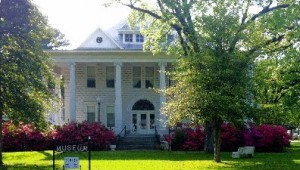Monticello Memories – Tour of the Museum -1
March 3rd, 2013 by This March, 2013, offering will begin a series that will give you a room-by-room tour of our own Drew County Historical Museum. I hope you will enjoy these entries and will stop by the museum yourself to peruse its treasures face-to-face.
This March, 2013, offering will begin a series that will give you a room-by-room tour of our own Drew County Historical Museum. I hope you will enjoy these entries and will stop by the museum yourself to peruse its treasures face-to-face.
The museum itself was formerly known as the Cavaness house for those of you who never knew, or have forgotten, its beginnings. Newlyweds Garvin W. Cavaness and his wife, Pattie Phenton Wells, began construction of their home in 1906.
As they were getting ready to build, Mr. Cavaness heard reports of a train derailment between Monticello and Dermott. When the railcars overturned, large quantities of cement spilled onto the ground. Mr. Cavaness went to the site and loaded the “dry” cement in wagons, hauled it back to Monticello and used it to make the bricks for the house. Mr. Cavaness, two helpers and friend George Burks made the bricks on the site, using the “brick-making machine” that still rests on the museum grounds. (That machine allegedly came to Drew County in a “package” as part of the catalog-ordered Sears house on North Main Street.)
Mr. Cavaness and his helpers also made the columns supporting the front portico of the house. (I’ve always speculated they used graduated cheese boxes for molds, but that is just my notion.) Now this majestic sample of homebuilding may seem a great undertaking for the time, but Mr. Cavaness was no ingénue. He had studied architecture at the University of Arkansas for a time. He originally built three rooms stacked on top of each other – a basement, kitchen and bedroom. The rest of the house was added after the young couple moved in.
The home was originally heated by steam. The lovely fanlight and sidelights surrounding the front glass-paneled door came from an old home in New Orleans. Mr. Cavaness had heard about the sale of its contents so he went to New Orleans and bought these lovely fixtures for his new home under construction in Monticello. These doorway ornamentations dated before the Civil War and are now well over 150 years old. It is believed that he brought them home wrapped in quilts in the back of a wagon.
The house originally had a wooden porch all the way around it. The hooks for a huge swing still can be seen on the north end of the front porch. I am told the swing was large enough to stretch out in on a summer day.
In the late 1930s-early 1940s the Cavanesses divided the second floor of the home into four apartments. Several couples who had married upon the groom’s return from WWII began their life together in an apartment in the Cavaness house.
After the deaths of both Cavanesses, a Mr. and Mrs. Hoyle from McGehee bought the house and once again it became a single family dwelling. They did much to restore and improve the house, including having the elegant red wallpaper in the dining room hung to replicate the original wallpaper.
After a few years the Hoyles grew tired and decided to sell out and move to Hot Springs. The furnishings and most other items in the house were sold at auction. There are only three objects still in the museum that we know are original to the house. One is the walnut spool bed located upstairs in the doll room. The bed came to the house from the “Old Campground” community in northern Drew County. Mr. Cavaness’s grandmother, Grandmother Green, owned the bed and later gave it to Mable Sherry whose family lived in an apartment in the house for a while. Mable was married in the house and later gave the bed to the museum. (She also owned the house behind the museum that is now the Archives.)
The second original piece to the house is a print hanging in the downstairs bedroom. It hangs in a gilded frame with a faded red velvet trim. The picture depicts a young girl and a lamb.
The last original item is a pair of gorgeous French blue candlesticks that rest on the mantel in the museum’s “office”. They belonged to the Cavenesses and were put up for auction when the home was sold. The story says that the late Mrs. Wilma Hankins, a beloved and respected teacher at the old high school formerly located on East College Street, passed by on her way home from school on the day of the auction and went inside. She saw the lovely candlesticks and bought them. At her request they were returned “home where they belonged” when she died.
The Cavaness house came up for sale in 1970 and was purchased for a museum at a cost of $20,000. It opened in the summer of 1971. Mr. and Mrs. Eric Hardy were some of its earliest promoters, donors and custodians.
This is just the beginning of the story of the Drew County Historical Museum and its many treasures. In the next few months you will be introduced to a myriad of its other holdings. Each has an interesting story. I hope your interest will be piqued and you will be encouraged to come to the museum and see these artifacts for yourself. The museum is open on Friday and Saturday afternoons, 2:00 – 5:00 p.m. We’ll be looking for you!
Choose another article
Newer article: Sunrise Glare Causes Close Call for Driver
Older article: Billies Bow to Pottsville 56-54 in State Playoffs

























































If you have never been to the museum you have missed a treat. It is something for Monticello and Drew County to be proud of. I had the privilege working there for several years with Ms. Henri Mason and learned something new almost every week.